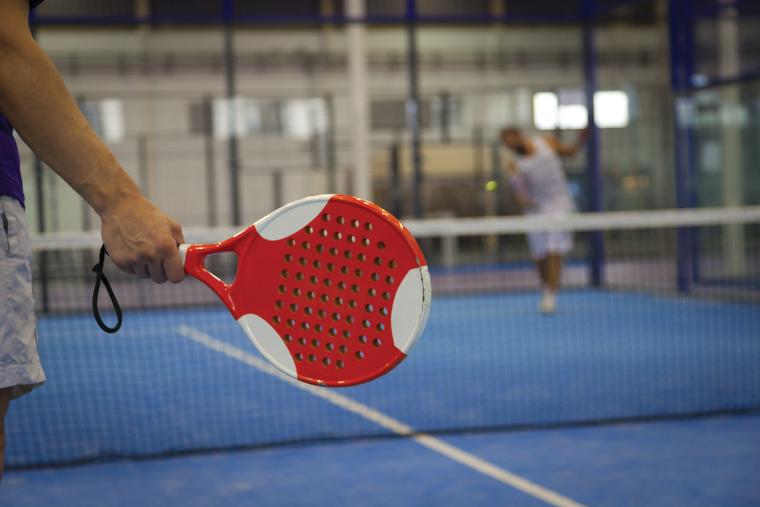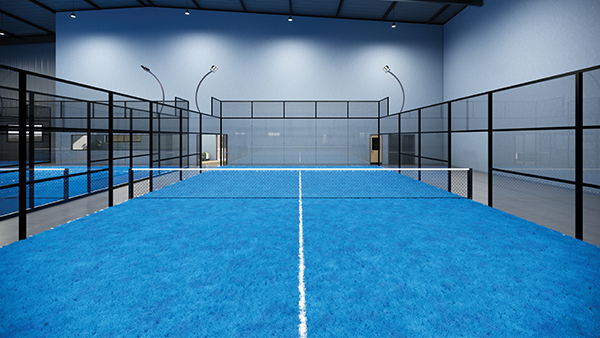
Padel is an up-and-coming court sport that resembles both pickleball and tennis, with elements of squash and racquetball as well. It is played in doubles on an enclosed court with a synthetic turf surface. The court walls are made of glass and metallic mesh.
While the scoring system in padel is similar to that of tennis, the equipment is different. Padel is played with a racquet that is more paddle-like in shape and design. The racquet is solid, with holes running through it. Padel is played with a ball that is slightly larger than a tennis ball.
The sport, which originated in Mexico, has been making inroads in the USA. Its national governing body is the US Padel Association, whose mission it is to lead padel’s growth and development in the United States. The international governing body is the International Padel Federation (FIP).
Scott Colebourne, association manager for the United States Padel Association (USPA), sat down with Sports Destination Management to share his thoughts on padel and its continued potential.

Growth in the USA
The USPA and padel in America have actually been around since the early 1990s, but just in the past five years, the sport has grown exponentially.
Demographics
The sport is about 80 percent male right now. We have some initiatives in place to try to bring in more women. It’s also largely adult with, unfortunately, not as much youth play. To address that, we just announced the launch of a Junior Grant program to provide financial support to USPA Premier Club Members that provides padel learning and playing opportunities for young players.
This focus on junior players ages 18 and under is core to the USPA’s mission to grow the game of padel in the U.S. This grant program provides meaningful financial support to clubs that support both junior development and the USPA and further demonstrates the USPA’s ongoing commitment to padel clubs and professionals across the country, especially those who dedicate time and resources to the sport’s junior players.
National Teams
One focus of USPA is the selection and support of a number of national teams, who represent this country in international competition. Teams include the following:
• US National Junior Padel Team: This team most recently traveled to Aguascalientes, Mexico to compete in the Pan American Championships.
• Women’s US National Team and Men’s National Team: These teams competed in the FIP World Padel Championships North American Qualifiers in early September, and both secured places in the FIP World Padel Championships in Doha, Qatar.
• Women’s US Senior National Team and Men’s US Senior National Team: These teams, comprised of players in age categories of 35+, 40+, 45+, 50+, 55+, compete in events including the FIP Seniors World Padel Championships. (The women’s team finished seventh out of 22 countries, while the men finished ninth.)
Facilities
Courts measure 66 feet by 33 feet and can be built indoors or outdoors – although there are more and more indoor facilities popping up. In general, the indoor facilities are better as they lend themselves to a more dependable game because you don’t have to worry about the wind or the sun – or the weather at all, for that matter.
Most padel is played in clubs rather than in municipal installations and the number of clubs is definitely growing; in the first six months of 2024, 25 new clubs were announced, meaning more opportunities in more cities for more players to take up the sport.
Also good news: We are seeing a lot of tennis clubs and pickleball clubs putting in padel as part of their multi-sport play areas. In fact, the USTA National Campus in Orlando has its own padel courts. Padel is a great workout and it’s a lot of fun. The court surface is forgiving and people can use the skills they have developed from other racquet or paddle sports. It’s played in doubles so it’s social. Padel is also a great way of capitalizing on unused, or underused space.
Once people see padel being played, they want to try it and once they try it, they stick with it. You can wear the same shoes and clothes as for other racquet and paddle sports; if the courts are there, the only things you really need to invest in are a racquet and the balls.
Where is Padel Most Popular?

Padel’s popularity around the globe includes hot spots in Spain, Argentina, Mexico, Sweden, United Arab Emirates, United Kingdom and Portugal – although it certainly is well represented in other countries as well.
Within the U.S, we have seen a lot of growth of padel in the southern part of Florida; there’s a very strong concentration of players there. Texas is another place padel is incredibly popular; there are many clubs in Houston, Austin, Dallas and San Antonio.
That’s not to say it isn’t popular in other parts of the country, though; one of the largest tournaments last year was held in New York. And if you look at USPA’s list of tournaments, you’ll also see events in California, New York, Connecticut, Philadelphia, Georgia, Missouri, North Carolina, Tennessee and more. (Padel’s growth in pockets around the USA is similar to that of a few other sports; one of these is platform tennis, which is very popular in the northeast.)
USPA’s Events
USPA sanctions tournaments at various levels and keeps a comprehensive list of those tournaments on its website, for those who want to find events where they can compete. Those tournaments include not just a location and the title of the event but a listing of the level of the event (we sanction tournaments at the 100, 250, 500 and 1000 levels; at higher levels, more prize money and points for winners are available).
We host four majors and one masters final; majors are spread across the country to give players a chance to compete. Currently, those events are all hosted in clubs.
Hosting Events
Championship events are hosted worldwide, and are bid out by our international governing body, FIP; any available information on hosting can be found on FIP’s website.
In 2022, the USA hosted the Electrolit Senior Padel World Championships at Real Racquet Academy Vegas (now known as P1 Padel). We were incredibly proud of this event since it showcased not just the ability of the USPA to put on an event but it illustrated the fact that the United States as a whole is a growing destination for padel.
Padel is growing in this country, and media coverage is increasing. American manufacturers are starting to make padel courts and components, and more brick and mortar stores, as well as online merchants, are stocking racquets and balls – all of which means padel is poised for absolutely explosive growth in the years to come. SDM
